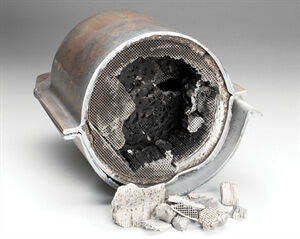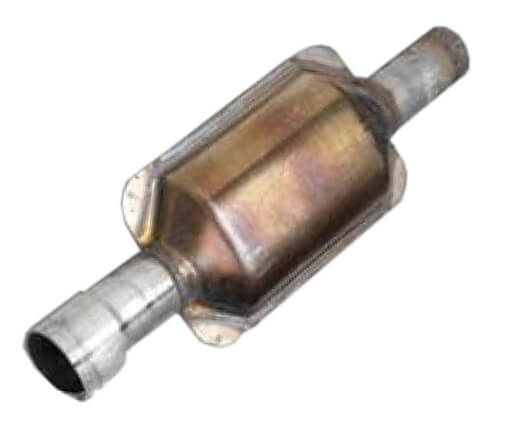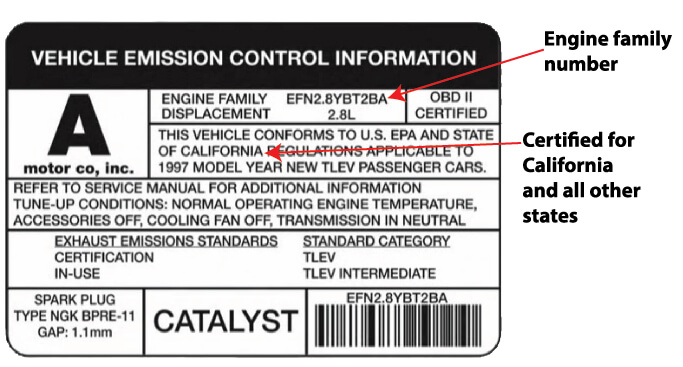How a catalytic converter works to reduce pollution
What is a catalytic converter and how does it work?
A catalytic converter is a metal container that houses a honeycomb ceramic structure  that’s coated with certain precious metals like platinum, palladium or rhodium. The converter’s job is to transform harmful exhaust into Carbon Dioxide (CO2), Water (H20) and Nitrogen (N2).
that’s coated with certain precious metals like platinum, palladium or rhodium. The converter’s job is to transform harmful exhaust into Carbon Dioxide (CO2), Water (H20) and Nitrogen (N2).
There are two types of catalytic converters:
• Two-way catalytic converter— The precious metals store excess oxygen from the exhaust and use it to convert carbon monoxide (C0) into carbon dioxide by adding one oxygen atom. The metals also oxidize any unburned or partially burned hydrocarbons left over from the combustion process, converter the excess hydrocarbons into carbon dioxide (C02) and water (H20).
Unfortunately, Two-way catalytic converters are unable to address the production of oxides of Nitrogen, which is a major component of smog. That’s where a Three-way catalytic converter comes into play.
• Three-way catalytic converter—Converts C0 and unburned hydrocarbons into C02 and H20 AND converts nitric oxide and nitrogen dioxide (NOx) into O2 and N2.
How does a catalytic converter work?
In a perfect world, the car’s computer would command a perfect air-to-fuel mixture resulting in perfect combustion. But that’s impossible in the real world because driver constantly adjusts the accelerator pedal and the computer is constantly adjusting the air fuel mixture to comply with the changing demand. If the computer overshoots the mark and provides too much fuel, the oxygen sensor sees the rich mixture in the exhaust and the computer responds by undershooting fuel. This back and forth narrows the range. However, when the mixture is too lean, all the gas is burned, leaving excess oxygen in the exhaust stream. The catalytic converter stores that excess exhaust. Then, when the mixture is rich, it releases the stored oxygen to complete the burning process and burn off the excess gas in the exhaust stream.
So a properly operating catalytic converter is constantly storing and releasing oxygen.
What damages a catalytic converter?
• Improper air/fuel control misfires are the single most common cause of catalytic converter failure. An air/fuel mixture that’s consistently too lean or too rich prevents complete combustion resulting in an exhaust that has too much oxygen from a lean mixture or excess fuel from a rich mixture. Improper air/fuel mixtures can be caused by leaking or plugged fuel injectors, improper fuel rail pressure or compromised MAP, MAF, ECT sensors.
• Ignition misfires also damage catalytic converters. A misfire caused by worn spark plugs, a shorted spark plug wire or an intermittent ignition coil causes excess fuel to enter the catalytic converter.
• Compromised cooling system where a failing head gasket leaks engine coolant into the exhaust stream and contaminates the catalytic converter
• Excessive engine wear where worn piston rings or worn valve guides allow excessive amounts of engine oil into the combustion chamber.
• Exhaust leaks that allow outside air to enter the exhaust and flood the catalytic converter with oxygen.
Extra fuel in the exhaust stream causes the catalytic converter to overheat,
reaching temperatures of up to 2,500°F. At that high temperature, the ceramic honeycomb begins to melt, reducing exhaust flow and limiting the converter’s ability to treat the exhaust.
How to diagnose a P0420 or P0430 catalytic converter efficiency code
Before you can diagnose a P0420 or P0430 code you have to understand the criteria the computer uses to set these codes. Catalytic converters are equipped with two oxygen sensors. The upstream sensor tells the computer how much oxygen is in the exhaust stream as it enters the converter. The computer uses this data to adjust air/fuel mixtures to obtain a better upstream reading. The downstream oxygen sensor tells the computer how much oxygen is LEFT in the exhaust AFTER it’s been treated by the catalytic converter. If the catalytic converter is doing its job, the downstream oxygen sensor should be fairly steady. If the downstream sensor reading is shifting rich and lean like the upstream oxygen sensor, that’s an indication the catalytic converter isn’t treating the exhaust at all. In most cases, that’s a sign of a dead catalytic converter, BUT you must conduct these other tests before replacing the catalytic converter. Keep in mind that converters never fail on their own, there’s always an underlying cause, and if you don’t fix that, you’ll just ruin the new converter. Here’s what you must check:
• Other trouble codes—Po420 and P0430 often appear with other performance related trouble codes. Misfire and air/fuel mixture related codes MUST be addressed first. Those types of codes CAUSE P0420 and P0430 codes, not the other way around.
• Live fuel trim data—If the fuel trims are within spec, you can rule out mixture induced misfires as the cause of a P0420 or P0430 code.
• Cooling system pressure check—Gasket failures can cause catalytic converter failure. If you have a gasket leak and don’t fix it, you’re wasting your money on a new cat.
• Metal discoloration—discolored metal on the catalytic converter case
is an indication of overheating and possible core meltdown. It’s never a good sign and almost means you’ve destroyed the converter.
• Exhaust system leaks—You would think that an exhaust system leak would push exhaust gas out of the hole—it does. But exhaust isn’t a steady stream, it’s actually a stream of pressurized pulses. In-between each pulse is a small amount of suction. That suction can pull outside air INTO the catalytic converter, messing up the efficiency. Here’s an example: Exhaust contains less than ½ of 1% oxygen. But outside air contains close to 21% oxygen. If you have even a pinhole leak in your exhaust system, it can suck in enough oxygen to throw off both the upstream and downstream oxygen sensors. Too much oxygen hitting the upstream sensor causes the computer to think you have a lean exhaust (combustion burned up all the fuel and left excess oxygen), and it will add fuel until it maxes out its available fuel trim. If you have an exhaust leak within 18” of the cat’s exit, that additional oxygen can force the downstream sensor to read constantly lean.
• Software updates. Many car makers have been forced to issue software updates to correct false P0420 and P0430 codes. Always check the most current service bulletins for your car before thinking about replacing emissions related parts.
How to shop for a new catalytic converter
Before you head to an auto parts store or online seller, you must read the Vehicle Emission Control Information (VECI) label. You’ll find it on the underside of your hood, strut tower, radiator support or fan shroud. If the car was made to meet California emissions, the VECI label will include the terms: CARB, California 50-state or ARM. If the label just says Federal, it’s not a California emissions vehicle. Both California and New York require CARB, California 50-state or ARM certified replacement converters.
In addition to certification ratings, you’ll also need the engine family number (EFN). Two engines, both with the same number of cylinders and displacement, made in the same year by the same car maker can have two different EFNs, so don’t make assumptions on this.
Aftermarket or OEM catalytic converter
OEM catalytic converters are sold by the dealer and are designed to meet new car standards, which means they’re warranted for 8-yrs or 80,000 miles, assuming you don’t destroy it by not repairing the root cause. Aftermarket converters, on the other hand, are designed to a much lower standard of only 25,000 miles. Deciding which type to buy is directly related to how long you intend to drive the car.
Direct fit catalytic converter versus universal fit catalytic converter
The distinction is pretty simple, a direct fit is designed to bolt right in place of your old converter without additional pipes or adapters. Universal converters are cheaper, but sometimes require quite a few additional parts to make them fit.
Posted on by Rick Muscoplat


